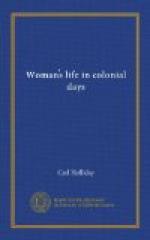The Puritan clergymen have been severely blamed for this strange wave of fanaticism, and no doubt, as leaders in the movement, they were largely responsible; but even their power and authority could never have caused such wide-spread terror, had not the women of the day given such active aid. The feminine soul, with its long pent emotions, craved excitement, and this was an opportunity eagerly seized upon. As Fisher says, “As their religion taught them to see in human nature only depravity and corruption, so in the outward nature by which they were surrounded, they saw forewarnings and signs of doom and dread. Where the modern mind now refreshes itself in New England with the beauties of the seashore, the forest, and the sunset, the Puritan saw only threatenings of terror."[33]
We cannot doubt in most instances the sincerity of these men and women, and in later days, when confessions of rash and hasty charges of action were made, their repentance was apparently just as sincere. Judge Sewall, for instance, read before the assembled congregation his petition to God for forgiveness. “In a short time all the people recovered from their madness, [and] admitted their error.... In 1697 the General Court ordered a day of fasting and prayer for what had been done amiss in the ‘late tragedy raised among us by Satan.’ Satan was the scapegoat, and nothing was said about the designs and motives of the ministers."[34] Possibly it was just as well that Satan was blamed; for the responsibility is thus shifted for one of the most hideous pages in American history.
IX. Religion Outside of New England
Apparently it was only under Puritanism that the colonial woman really suffered through the requirements of her religion. In other colonies there may have been those who felt hampered and restrained; but certainly in New York, Pennsylvania, and the Southern provinces, there was no creed that made life an existence of dread and fear. In most parts of the South the Established Church of England was the authorized, or popular, religious institution, and it would seem that the women who followed its teachings were as reverent and pious, if not so full of the fear of judgment, as their sisters to the North. The earliest settlers of Virginia dutifully observed the customs and ceremonies of the established church, and it was the dominant form of religion in Virginia and the Carolinas throughout the colonial era. John Smith has left the record of the first place and manner of divine worship in Virginia: “Wee did hang an awning, which is an old saile, to three or four trees to shadow us from the Sunne; our walls were railes of Wood; our seats unhewed trees till we cut plankes; our Pulpit a bar of wood nailed to two neighbouring trees. In foul weather we shifted into an old rotten tent; this came by way of adventure for new. This was our Church till we built a homely thing like a barne set upon Cratchets, covered with rafts, sedge, and earth; so also was the walls; the best of our houses were of like curiosity.... Yet we had daily Common Prayer morning and evening; every Sunday two sermons; and every three months a holy Communion till our Minister died: but our Prayers daily with an Homily on Sundays wee continued two or three years after, till more Preachers came.”




